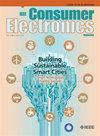Efficient Path-Following for Urban Logistics: A Fuzzy Control Strategy for Consumer UAVs Under Disturbance Constraints
IF 10.9
2区 计算机科学
Q1 ENGINEERING, ELECTRICAL & ELECTRONIC
引用次数: 0
Abstract
The adoption of consumer unmanned aerial vehicles (UAVs) for logistics transportation is a key aspect of the emerging low-altitude economy, yet it faces significant challenges. Urban environments introduce complex obstacles, including dense buildings and unpredictable wind disturbances, while existing control methods struggle to balance path-following accuracy, disturbance rejection, and communication efficiency. To meet these demands, this paper proposes a quantized fuzzy learning path-following control for consumer UAVs. Firstly, a hysteresis quantized fuzzy disturbance observer (HQFDO) is proposed where the disturbances are approximately estimated by a neural network. Notably, a hysteresis quantizer is employed to reduce the communication bandwidth occupation by discretizing disturbance observations. Subsequently, a distributed velocity controller and a heading angle controller are designed to tackle the geometric and dynamic tasks separately. Specifically, the velocity controller introduces a projective arc length error to mitigate inefficiencies and safety risks associated with frequent acceleration and deceleration switches. Compared to conventional techniques, the proposed approach improves transient performance, enhances path attractivity, and optimizes communication resource utilization. Theoretical stability analysis is provided, and simulations validate the effectiveness of the proposed control strategy.城市物流的高效路径跟踪:干扰约束下消费类无人机的模糊控制策略
采用消费者无人机(uav)进行物流运输是新兴低空经济的一个关键方面,但它面临着重大挑战。城市环境引入了复杂的障碍,包括密集的建筑物和不可预测的风干扰,而现有的控制方法难以平衡路径跟踪的准确性、干扰抑制和通信效率。为了满足这些需求,本文提出了一种用于消费无人机的量化模糊学习路径跟踪控制。首先,提出了一种迟滞量化模糊扰动观测器(HQFDO),该观测器采用神经网络对扰动进行近似估计。值得注意的是,迟滞量化器通过离散干扰观测值来减少通信带宽占用。随后,设计了分布式速度控制器和航向角控制器,分别处理几何任务和动态任务。具体来说,速度控制器引入了一个投影弧长误差,以减轻频繁加速和减速开关带来的效率低下和安全风险。与传统方法相比,该方法提高了暂态性能,增强了路径吸引力,优化了通信资源利用率。给出了理论稳定性分析,并通过仿真验证了所提控制策略的有效性。
本文章由计算机程序翻译,如有差异,请以英文原文为准。
求助全文
约1分钟内获得全文
求助全文
来源期刊
CiteScore
7.70
自引率
9.30%
发文量
59
审稿时长
3.3 months
期刊介绍:
The main focus for the IEEE Transactions on Consumer Electronics is the engineering and research aspects of the theory, design, construction, manufacture or end use of mass market electronics, systems, software and services for consumers.

 求助内容:
求助内容: 应助结果提醒方式:
应助结果提醒方式:


